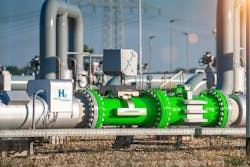Pratt & Whitney to demonstrate hydrogen-powered turboprop
MONTREAL - Pratt & Whitney Canada in Montreal is set to test hydrogen combustion technology on its PW127XT regional turboprop engine as part of Canada’s Initiative for Sustainable Aviation Technology (INSAT). This initiative, named the Hydrogen Advanced Design Engine Study (HyADES), involves collaboration with Next Hydrogen Solutions Inc., which will develop high-efficiency, cost-effective electrolyzers for hydrogen production infrastructure. Pratt & Whitney operates as a business of RTX in Arlington County, Va.
"This collaborative project with INSAT enables us to develop key technologies for future hydrogen-powered aircraft and complements our wider efforts to advance aviation sustainability through a range of pathways, including continued improvements to engine efficiency, hybrid-electric propulsion, and compatibility with sustainable aviation fuel (SAF)," said Edward Hoskin, vice president of engineering at Pratt & Whitney Canada. "While regional aviation represents one of the most promising use cases for hydrogen, the project will also demonstrate the versatility of adapting the proven, highly efficient PW127XT turboprop engine to operate with low carbon alternative fuels and continues our legacy of technology leadership in this segment."
The initial project phase includes testing fuel nozzles and combustors with hydrogen fuel, followed by full engine ground testing in later phases. Part of the PW100 series, the PW127XT engine was launched in 2021 as Pratt & Whitney Canada's most advanced turboprop engine.
Related: airBaltic selects Pratt & Whitney's EngineWise tech for maintenance
"We are thrilled to collaborate with INSAT and Pratt & Whitney Canada on this project," said Raveel Afzaal, president and CEO of Next Hydrogen Solutions Inc. "The ability to produce green hydrogen at scale will be a critical enabler for reducing aviation CO2 emissions, whether using hydrogen as a direct fuel for combustion or as feedstock for SAF."
In another INSAT-backed effort, Pratt & Whitney Canada is working with Derivation Research Laboratory (DRL) on the Turbine Engine Advanced Materials for Efficiency (TEAME) project. This venture aims to explore advanced materials for gas turbine engine hot sections, seeking improved thermal efficiency and reduced fuel consumption and emissions. Pratt & Whitney Canada will lead the project, providing technical oversight and management, while DRL will contribute advanced materials testing capabilities.
